2010 Value SSD (~$100) Roundup: Kingston and OCZ take on Intel
by Anand Lal Shimpi on June 3, 2010 12:01 AM ESTSequential Read/Write Speed
Using the 6-22-2008 build of Iometer I ran a 3 minute long 2MB sequential test over the entire span of the drive. The results reported are in average MB/s over the entire test length:
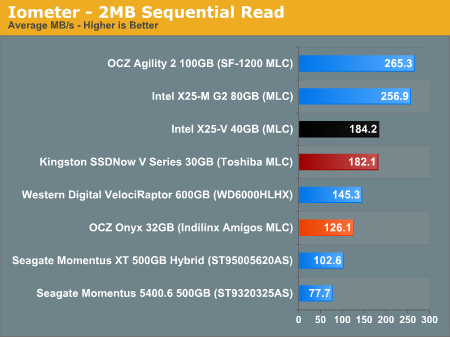
Sequential read/write performance suffers on these entry level drives. Remember that these drives hit their low capacities (and price points) by leaving half of the NAND channels unpopulated, which means in situations where you've got a ton of data to transfer in parallel you're going to be slower than a high end SSD. In read speed the Intel and Kingston drives are limited to around 180MB/s, still faster than any desktop hard drive. Sequential write speeds are slower than 2.5" hard drives however:
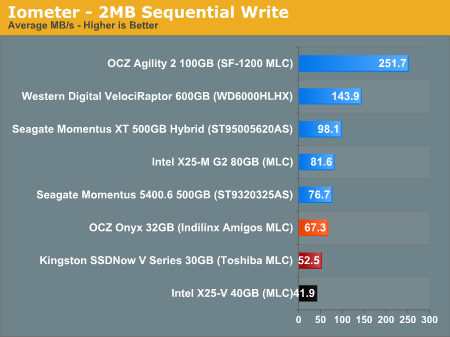
Random Read/Write Speed
This test reads/writes 4KB in a completely random pattern over an 8GB space of the drive to simulate the sort of random access that you'd see on an OS drive (even this is more stressful than a normal desktop user would see). I perform three concurrent IOs and run the test for 3 minutes. The results reported are in average MB/s over the entire time.
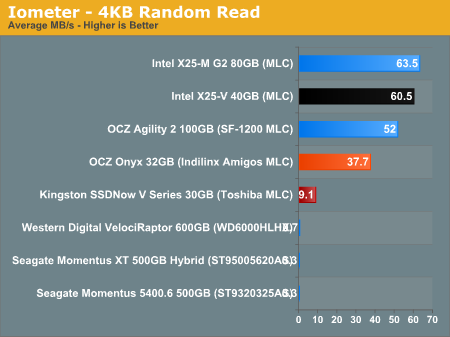
Improved random read and write performance are SSD advantages. Even the cheaper drives hold this advantage over the fastest hard drives. While the 600GB VelociRaptor is stuck at 0.7MB/s in our random read test, Intel's X25-V delivers 60.5MB/s. The best performer here out of the value drives is the Intel X25-V, followed by OCZ's Onyx.
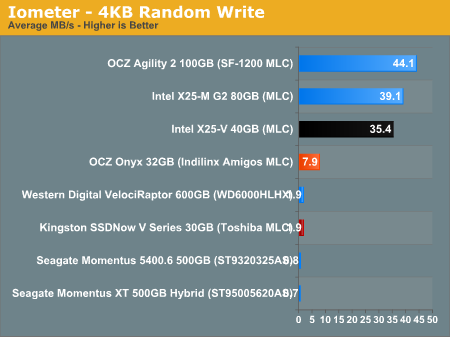
Many of you have asked for random write performance at higher queue depths. What I have below is our 4KB random write test performed at a queue depth of 32 instead of 3. While the vast majority of desktop usage models experience queue depths of 0 - 5, higher depths are possible in heavy I/O workloads:
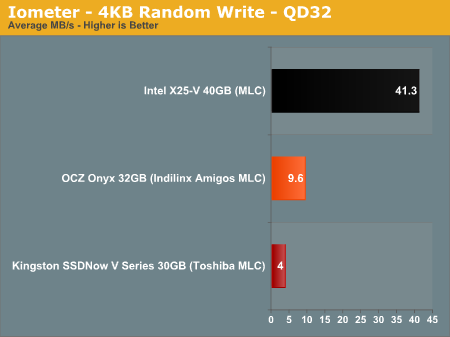
All of the value SSDs improve performance as they are able to extract more parallelism out of the data and thus get better NAND/controller utilization, but the standings don't change: Intel is on top, followed by OCZ and Kingston at a distant 2nd and 3rd place.










49 Comments
View All Comments
cknobman - Thursday, June 3, 2010 - link
Your reviews always show a breakdown of how a drive performs before and after TRIM. How are you issuing the TRIM command? I thought by default Windows 7 always issued the TRIM command on every operation as long as your drive supported it.gaspard - Sunday, June 6, 2010 - link
well you can disable it via Windows' fsutil command: fsutil behavior query DisableDeleteNotify NO TRIM: fsutil behavior set DisableDeleteNotify 1 TRIM ON: fsutil behavior set DisableDeleteNotify 0GullLars - Thursday, June 3, 2010 - link
I've been waiting for an article like this for a few months now, and you did a good job Anand, as always ;)I have a couple of questions:
Why not include OCZ Agility 30GB? ($119 @ newegg)
Why only test random write and not read at QD 32?
There is little difference in random writes, but random reads double for the x25-V, and i'd guess increase a bit for the Onyx too.
A full Barefoot drive can do 60MB/s random read @ QD 5.
x25-V can do about 70MB/s @ QD 4, and about 100MB/s @ QD 8 for random reads.
Why not include PCmark Vantage HDD subscores?
They are made to showcase the strong and weak points of storage performance, and are relevant to what drive to pick. The total HDD score can be the same for two drives with completely different strenghts.
Dylock - Thursday, June 3, 2010 - link
The OCZ Agility 60GB is on sale at Amazon.com for 144$, as of today. That's $2.4 per GB.An Indilix controller to boot. The lower grade memory comes into play for performance , but not by much.
Movieman420 - Thursday, June 3, 2010 - link
Currently a 30gb Vertex is $109 ($99 after rebate)! Instead the Onyx was used which uses 'half' of an Idilinx controller (Indilinx Amigo). I know you had an Onyx handy cuz of recent testing but really. Even tho the Vertex is 'old gear', it woulda blew the doors off the other drives in your testing.u.of.ipod - Thursday, June 3, 2010 - link
I want a SSD for my HTPC. Hopefully it can be shutdown and booted up more quickly, be more responsive in Windows Media Center 7 and finally to provide space for a second 3.5" storage drive. Is one of these value drives for me? Should I just choose a 2.5" mechanical drive instead?kmmatney - Friday, June 4, 2010 - link
The Intel 40 GB SSD works fine on Windows XP without TRIM. Just install the Intel SSD Toolbox, and it will perform a "TRIM" or garbage collection routine automatically, once a week.kmmatney - Friday, June 4, 2010 - link
Whoops - was supposed to be a new comment, and not a "reply"...gaspard - Sunday, June 6, 2010 - link
whichever one you like, and NO... those are the answers respectivelymrmike_49 - Saturday, June 5, 2010 - link
I'd like to see tests of loading times for various games, start-up as well as level loads. Games are an ideal use for SSDs, many many Reads, very few Writes. A $100 SSD that could triple my load speed (or more) would be nice.How about redoing this review, concentrating on actual load start-up times and level loads of popular games??!!